Manx shearwater
The Manx shearwater (Puffinus puffinus) is a medium-sized shearwater in the seabird family Procellariidae. The scientific name of this species records a name shift: Manx shearwaters were called Manks puffins in the 17th century. Puffin is an Anglo-Norman word (Middle English pophyn) for the cured carcasses of nestling shearwaters. The Atlantic puffin acquired the name much later, possibly because of its similar nesting habits.
| Manx shearwater | |
|---|---|
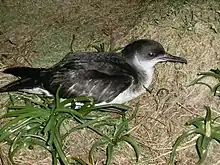 | |
| On Skomer | |
| Recording from Skomer Island, Wales | |
| Scientific classification | |
| Domain: | Eukaryota |
| Kingdom: | Animalia |
| Phylum: | Chordata |
| Clade: | Dinosauria |
| Class: | Aves |
| Order: | Procellariiformes |
| Family: | Procellariidae |
| Genus: | Puffinus |
| Species: | P. puffinus |
| Binomial name | |
| Puffinus puffinus (Brünnich, 1764) | |
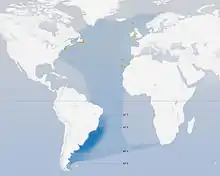 | |
Breeding colonies (ranges are approximate)Non-breeding visitor | |
| Synonyms | |
|
Procellaria puffinus Brünnich, 1764 | |
Taxonomy
The shearwaters form part of the family Procellariidae, a widespread group containing nearly 100 species of medium to large seabirds. They have long, narrow wings and the characteristic “tube nose”.[2] Although it was considered a monotypic species, recently an endemic subspecies for the Canary Islands has been proposed P. puffinus canariensis.[3] The large genus Puffinus includes several species formerly considered to be subspecies of the Manx shearwater, including the yelkouan shearwater, Balearic shearwater, Hutton's shearwater, black-vented shearwater, fluttering shearwater,[4] Townsend's shearwater and the Hawaiian shearwater.[5][6] Of these, the Hawaiian and possibly Townsend's shearwaters seem to be most closely related to the Manx shearwater.[5]
Three extinct species appear to be closely related to the Manx shearwater, the lava shearwater,[7] the dune shearwater and Scarlett's shearwater.[8][9] DNA recovered from the lava shearwater of the Canary Islands suggests that it is the Manx shearwater's sister species despite being significantly smaller.[10]
The Manx shearwater was first described by Danish zoologist Morten Thrane Brünnich as Procellaria puffinus in 1764.[4][11] The current scientific name Puffinus derives from "puffin" and its variants, such as poffin, pophyn, and puffing,[12] which referred to the cured carcass of the fat nestling of the shearwater, a former delicacy.[13] The original usage dates from at least 1337, but from as early as 1678, the term gradually came to be used for another seabird, the Atlantic puffin.[12] The current English name was first recorded in 1835 and refers to the former nesting of this species on the Isle of Man.[14]
Description
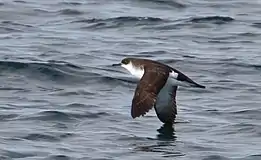
The Manx shearwater is 30–38 cm (12–15 in) with a 76–89 cm (30–35 in) wingspan and weighs 350–575 g (12+1⁄2–20+1⁄2 oz).[4] It has the typically "shearing" flight of the genus, dipping from side to side on stiff wings with few wingbeats, the wingtips almost touching the water. This bird looks like a flying cross, with its wings held at right angles to the body, and it changes from black to white as the black upper parts and white under sides are alternately exposed as it travels low over the sea.
Voice
This shearwater is mainly silent at sea, even when birds are gathered off the breeding colonies. It calls on its nocturnal visits to the nesting burrows in flight, on the ground, and in the burrows, although moonlight depresses the amount of calling. The vocalisations largely consists of a raucous series of croons, howls, and screams, typically in groups of a few syllables, which become weaker and throatier. The male has some clear ringing and shrieking tones absent from the harsher repertoire of the female, the difference being obvious when a pair duets.
The nocturnal vocalisations of Manx shearwater are notorious for their eerie character and the alarm they might arouse in uninitiated hearers. Anecdotally: "the diabolical shrieks and cackles of this species have earned it, in various parts of the world and various languages, the local nickname 'Devil Bird'".[15]
Females can recognise the voice of their mates, but not of their young.[4][16] They do not provide postnesting care, and a chick in their burrow is likely their own, so voice identification is not needed.[17]
Vision
The vision of the Manx shearwater has a number of adaptations to its way of life. Like other tube-nosed seabirds, it has a long, narrow area of visual sensitivity containing the fovea across the retina of the eye.[19] This region is characterised by the presence of ganglion cells that are regularly arrayed and larger than those found in the rest of the retina. This feature helps in the detection of items in a small area projecting below and around the bill. It may assist in the detection of prey near the sea surface as a bird flies low over it.[20]
Since it visits its breeding colony at night, a shearwater has adaptations for nocturnal vision, too. In the shearwater's eyes, the lens does most of the bending of light necessary to produce a focused image on the retina. The cornea, the outer covering of the eye, is relatively flat, so of low refractive power. In a diurnal bird like a pigeon, the reverse is true; the cornea is highly curved and is the principal refractive component. The ratio of refraction by the lens to that by the cornea is 1.6 for the shearwater and 0.4 for the pigeon. The shorter focal length of shearwater eyes give them a smaller, but brighter, image than is the case for pigeons. Although the Manx shearwater has adaptations for night vision, the effect is small, and these birds likely also use smell and hearing to locate their nests.[21]
Distribution and habitat
The Manx shearwater is entirely marine, typically flying within 10 m (30 ft) of the sea surface. It nests in burrows on small islands, which it visits only at night.[22] Its nesting colonies are in the north Atlantic Ocean in the United Kingdom, Ireland, Iceland, the Faroe Islands, France, the Isle of Man, the Channel Islands, the Azores, Canary Islands, and Madeira. The most important colonies, with a total of more than 300,000 pairs, are on islands off Wales, Scotland, and Northern Ireland. Three-quarters of the British and Irish birds breed on just three islands; Skomer, Skokholm, and Rùm. Around 7000–9000 pairs breed in Iceland, with at least 15,000 pairs on the Faeroes. Other populations are of at most a few hundred pairs. The northeast of North America has recently been colonised from Newfoundland and Labrador to Massachusetts; although breeding was first recorded in 1973, populations remain small. Records in the northeast Pacific are increasing, and breeding has been suspected in British Columbia and Alaska.[4][23]
During the breeding-season birds regularly commute between their colonies and offshore feeding grounds that can be up to 1,500 km away.[24] For example, adult Manx shearwaters rearing their chick on the west coast of Ireland have been observed to travel all the way to the Mid-Atlantic Ridge to feed when the conditions are right.[24]
The breeding colonies are deserted from July to March, when the birds migrate to the South Atlantic, wintering mainly off Brazil and Argentina, with smaller numbers off southwest South Africa.[25] Juvenile birds undertake their first migration without their parents. Only a few days after leaving the nest, these birds can already travel up to 2000 km.[26] The journey south can be over 10,000 km (6,000 mi),[27] so a 50-year-old bird has probably covered over a million km (600,000 mi) on migration alone. The migration also appears to be quite complex, containing many stopovers and foraging zones throughout the Atlantic Ocean.[28] Ornithologist Chris Mead estimated that a bird ringed in 1957 when aged about 5 years and still breeding on Bardsey Island off Wales in April 2002 had flown over 8 million km (5 million mi) in total during its 50-year life.[29]
Manx shearwaters are able to fly directly back to their burrows when released hundreds of kilometres away, even inland.[30]
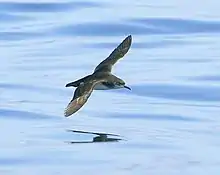
Behaviour
Manx shearwaters are long-lived birds. A Manx shearwater breeding on Copeland Island, Northern Ireland, was as of 2003/04, the oldest known living wild bird in the world: ringed as an adult (at least 5 years old) in July 1953, it was retrapped in July 2003, at least 55 years old.[31]
This is a gregarious species, which can be seen in large numbers from boats or headlands, especially on migration in autumn. It is silent at sea, but at night, the breeding colonies are alive with raucous cackling calls.
Breeding
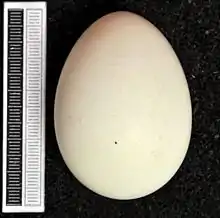
Although shearwaters return to the breeding colonies from March onwards, the females often then leave again for 2–3 weeks before egg-laying in early May. Males return to the colonies in which they were hatched, but up to half of females may move elsewhere. The nest is a burrow, often previously excavated by a European rabbit, although shearwaters can dig their own holes. Suitable holes under rocks may also be used. The burrows may be reused in subsequent years.[4]
The single white egg averages 61 mm × 42 mm (2+1⁄2 in × 1+3⁄4 in) and weighs 57 g (2 oz), of which 7% is shell.[32]
Food and feeding
The Manx shearwater feeds on small fish (herrings, sprats, and sand eels), crustaceans, cephalopods, and surface offal. The bird catches food off the surface or by pursuit diving, and forages alone or in small flocks. It can be attracted by feeding cetaceans, but rarely follows boats or associates with other shearwater species.[4]
Tube-nosed seabirds can detect food items at a distance of several tens of kilometres using their sense of smell to detect offal and compounds such as dimethyl sulfoxide produced when phytoplankton is consumed by krill. They track across the wind until they find a scent and then follow it upwind to its origin.[33]
.jpg.webp)
Rafting
Manx shearwaters engage in a behaviour termed "rafting", where birds sit, often in large groups of more than 10,000, on the water adjacent to their Skomer Island breeding colony before and after visiting their chicks. Rafts move closer to the island during the night and further away in the morning which produces a "halo" effect - where no birds are found close to the island during daylight. These day-night cycles of rafting distributions are prominent for Manx shearwaters around Skomer Island and might provide a way of waiting for dusk that reduces predation risk.[34]
Predators and parasites
Because of their lack of mobility on land, Manx shearwaters are vulnerable to attack by large gulls, such as the great black-backed gull,[35] and great skua.[36] Birds of prey such as the peregrine falcon and golden eagle are also recorded as killing adult birds.[37]
Rats and cats are a serious problem where they are present; the large shearwater colony on the Calf of Man was destroyed by rats that arrived from a shipwreck in the late 18th century.[38] European hedgehogs eat the eggs of nesting seabirds where they have been introduced.[36] Red deer have been recorded killing and eating young shearwaters on at least Foula, Skokholm, and Rùm; on the latter island, 4% of the chicks are killed by deer, and sheep have also been involved.[39] The reason for the carnivorous behaviour is thought to be a need for extra calcium.[40]
Manx shearwaters frequently carry feather lice (Mallophaga) most of which are either the feather-eaters in the groups Ischnocera, or Amblycera, which also consume blood. The most common are the ischnocerans Halipeurus diversus and Trabeculus aviator. The nests of breeding birds frequently contain the shearwater flea; Ornithopsylla laetitiae is also commonly present, which shares a common ancestry with North American rabbit fleas.[41] Where their burrows are near those of Atlantic puffins, the tick Ixodes uriae is common.[42] The mite Neotrombicula autumnalis is often present, and has been implicated in spreading puffinosis.[42] Puffinosis is a viral disease of in which young birds get blisters on their feet, conjunctivitis, and problems with movement. The death rate can reach 70% in infected birds.[43][44] Internal parasites include the tapeworm Tetrabothrius cylindricus.[45]
Status
The European population of the Manx shearwater has been estimated at 350,000–390,000 breeding pairs or 1,050,000–1,700,000 individual birds, and makes up 95% of the world total numbers. Although this species' population now appears to be declining, the decrease is not rapid or large enough to trigger conservation vulnerability criteria. Given its high numbers, this shearwater is therefore classified by the International Union for Conservation of Nature as being of least concern.[1]
In the north of its range, numbers are stable and the range is expanding, but human activities are affecting populations in the Macaronesian islands in the eastern Atlantic Ocean. These include birds stranded when dazzled by artificial lighting. As with other shearwaters and petrels, newly fledged Manx shearwaters are susceptible to grounding in built-up areas due to artificial light. The moon cycle and strong onshore winds largely influence grounding events in west Scotland, and visibility conditions to a lesser extent.[46] Around 1000–5000 chicks a year are legally taken for food in the Faroes. Introduced mammals are a problem, although populations can recover when rats and cats are removed from islands. Rabbits may try to occupy burrows, but also dig new tunnels.[4]
In culture
The large chicks of the Manx shearwater are very rich in oil from their fish diet and have been eaten since prehistoric times. They are easily extricated from their burrows, and the annual crop from the Calf of Man may have been as high as 10,000 birds per year in the 17th century. The young birds were also eaten in Ireland, Scotland, and the Scottish islands.[47]
The eerie, nocturnal cries of nesting shearwaters and petrels has led to associations with the supernatural. The breeding colonies at Trollaval on Rùm and Trøllanes and Trøllhøvdi in the Faroe Islands are believed to have acquired their troll associations from the night-time clamour.[48]
References
- BirdLife International (2018). "Puffinus puffinus". IUCN Red List of Threatened Species. 2018: e.T22698226A132636603. doi:10.2305/IUCN.UK.2018-2.RLTS.T22698226A132636603.en. Retrieved 11 November 2021.
- Hoyo, Josep del; Elliott, Andrew; Sargatal, Jordi; Christie, David A; de Juana, Eduardo, eds. (2013). "Procellariidae: Petrels, Shearwaters". Handbook of the Birds of the World Alive. Barcelona: Lynx Edicions. Retrieved 14 December 2014. (subscription required)
- Rodríguez, Airam; Rodríguez, Beneharo; Montelongo, Tinguaro; Garcia‐Porta, Joan; Pipa, Tania; Carty, Martin; Danielsen, Jóhannis; Nunes, João; Silva, Carlos; Geraldes, Pedro; Medina, Félix M; Illera, Juan Carlos (15 September 2020). "Cryptic differentiation in the Manx Shearwater hinders the identification of a new endemic subspecies". Journal of Avian Biology. 51 (11): jav.02633. doi:10.1111/jav.02633. hdl:10261/221075. S2CID 224927618.
- Hoyo, Josep del; Elliott, Andrew; Sargatal, Jordi; Christie, David A; de Juana, Eduardo, eds. (2013). "Manx Shearwater (Puffinus puffinus)". Handbook of the Birds of the World Alive. Barcelona: Lynx Edicions. Retrieved 11 October 2014. (subscription required)
- Austin, Jeremy J; Bretagnolle, Vincent; Pasquet, Eric (2004). "A global molecular phylogeny of the small Puffinus shearwaters and implications for systematics of the Little-Audubon's Shearwater complex" (PDF). Auk. 121 (3): 847–864. doi:10.2307/4090321. JSTOR 4090321. Archived from the original (PDF) on 2015-06-21. Retrieved 2014-12-20.
- Murphy, Robert Cushman (1952). "The Manx Shearwater, Puffinus puffinus, as a species of world-wide distribution" (PDF). American Museum Novitates (1586): 1–21.
- Rando, J C; Alcover, J A (2008). "Evidence for a second western Palaearctic seabird extinction during the last Millennium: the Lava Shearwater Puffinus olsoni". Ibis. 150 (1): 188–192. doi:10.1111/j.1474-919X.2007.00741.x. hdl:10261/85855.
- Rando, Juan Carlos & Alcover, Josep Antoni (2009). "On the extinction of the Dune Shearwater (Puffinus holeae) from the Canary Islands" (PDF). Journal of Ornithology. 151 (2): 365–369. doi:10.1007/s10336-009-0463-6. S2CID 22324745.
- Holdaway, R N; Worthy, T H (1994). "A new fossil species of shearwater Puffinus from the Late Quaternary of the South Island, New Zealand, and notes on the biogeography and evolution of the Puffinus gavia superspecies". Emu. 94 (3): 201–215. doi:10.1071/mu9940201.
- Ramirez, O; Illera, J C; Rando, J C; Gonzalez-Solis, J; Alcover, J A; Lalueza-Fox, C (2010). "Ancient DNA of the extinct Lava Shearwater (Puffinus olsoni) from the Canary Islands reveals incipient differentiation within the P. puffinus complex". PLOS ONE. 5 (12): e16072. Bibcode:2010PLoSO...516072R. doi:10.1371/journal.pone.0016072. PMC 3013140. PMID 21209838.
- Brünnich, Morten Thrane (1764). Ornithologia Borealis (in Latin). Hafniae [Copenhagen]. p. 29.
- "Puffin". Oxford English Dictionary. Oxford University Press. Retrieved 14 December 2014.(subscription required)
- Jobling, James A (2010). The Helm Dictionary of Scientific Bird Names. London: Christopher Helm. ISBN 978-1-4081-2501-4. p. 323.
- "Manx". Oxford English Dictionary. Oxford University Press. Retrieved 14 December 2014.(subscription required)
- Dawkins, Richard, 2006: The God Delusion, chapter 3, section 4: "The argument from personal experience" ISBN 9780593055489
- Snow, David; Perrins, Christopher M., eds. (1998). The Birds of the Western Palearctic concise edition (2 volumes). Oxford: Oxford University Press. ISBN 978-0-19-854099-1.
- Brooke, Michael (2010). The Manx Shearwater. Poyser Monographs. London. ISBN 978-1408137536.
{{cite book}}: CS1 maint: location missing publisher (link) p. 195. - Schematic diagram of retina of right eye, loosely based on Sturkie (1998) p. 6.
- Güntürkün, Onur, "Structure and functions of the eye" in Sturkie (1998) pp. 1–18.
- Hayes, Brian (1991). "Novel area serving binocular vision in the retinae of procellariiform seabirds". Brain, Behavior and Evolution. 37 (2): 79–84. doi:10.1159/000114348. PMID 2054586.
- Martin, Graham R; Brooke, M de L (1991). "The eye of a procellariiform seabird, the Manx Shearwater, Puffinus puffinus: Visual fields and optical structure". Brain, Behavior and Evolution. 37 (2): 65–78. doi:10.1159/000114347. PMID 2054585.
- Snow, David; Perrins, Christopher M., eds. (1998). The Birds of the Western Palearctic concise edition (2 volumes). Oxford: Oxford University Press. ISBN 978-0-19-854099-1. pp. 51–52.
- Goettel, Beth (8 September 2009). "Manx Shearwaters decide National Wildlife Refuge is perfect place to raise a chick". U S Fish and Wildlife Service. Retrieved 25 January 2013.
- Wischnewski, Saskia; Arneill, Gavin E.; Bennison, Ashley W.; Dillane, Eileen; Poupart, Timothée A.; Hinde, Camilla A.; Jessopp, Mark J.; Quinn, John L. (2019-05-01). "Variation in foraging strategies over a large spatial scale reduces parent–offspring conflict in Manx shearwaters". Animal Behaviour. 151: 165–176. doi:10.1016/j.anbehav.2019.03.014. ISSN 0003-3472. S2CID 121657271.
- Onley, Derek; Scofield, Paul (2007). Albatrosses, Petrels and Shearwaters of the World (Helm Field Guides). London: Christopher Helm. p. 17. ISBN 978-0-7136-4332-9. pp. 202–203.
- Wynn, Joe; Guilford, Tim; Padget, Oliver; Perrins, Chris M.; McKee, Neville; Gillies, Natasha; Tyson, Chris; Dean, Ben; Kirk, Holly; Fayet, Annette L. (April 2022). "Early‐life development of contrasting outbound and return migration routes in a long‐lived seabird". Ibis. 164 (2): 596–602. doi:10.1111/ibi.13030. ISSN 0019-1019.
- Guilford, T G; Meade, J; Willis, J; Phillips, R A; Boyle, D; Roberts, S; Collett, M; Freeman, R; Perrins, C M (2009). "Migration and stopover in a small pelagic seabird, the Manx shearwater Puffinus puffinus: insights from machine learning". Proceedings of the Royal Society B. 276 (1660): 1215–1223. doi:10.1098/rspb.2008.1577. PMC 2660961. PMID 19141421.
- Freeman, R.; Dean, B.; Kirk, H.; Leonard, K.; Phillips, R. A.; Perrins, C. M.; Guilford, T. (2013). "Predictive ethoinformatics reveals the complex migratory behaviour of a pelagic seabird, the Manx Shearwater". Journal of the Royal Society Interface. 10 (84): 20130279. doi:10.1098/rsif.2013.0279. PMC 3673166. PMID 23635496.
- "Oldest bird clocks 5 million miles". CNN.com. 18 April 2002. Retrieved 31 March 2013.
- Birkhead (2012) pp. 168–172.
- Jacquie A. Clark; Robert A. Robinson; Dawn E. Balmer; Sue Y. Adams; Mark P. Collier; Mark J. Grantham; Jeremy R. Blackburn & Bridget M. Griffin (2004). "Bird ringing in Britain and Ireland in 2003". Ringing and Migration. 22 (2): 114. doi:10.1080/03078698.2004.9674318.
- "Manx Shearwater Puffinus puffinus [Brünnich, 1764]". BirdFacts. British Trust for Ornithology (BTO). 16 July 2010. Retrieved 17 January 2015.
- Birkhead (2012) pp. 154–158.
- Richards, Cerren; Padget, Oliver; Guilford, Tim; Bates, Amanda E. (2019-10-21). "Manx shearwater (Puffinus puffinus) rafting behaviour revealed by GPS tracking and behavioural observations". PeerJ. 7: e7863. doi:10.7717/peerj.7863. ISSN 2167-8359. PMC 6812691. PMID 31656697.
- "Skomer Island: Manx Shearwater Factsheet" (PDF). The Wildlife Trust of South and West Wales. Archived from the original (PDF) on 18 December 2014. Retrieved 17 December 2014.
- Heaney, V; Ratcliffe, N; Brown, A; Robinson, P J; Lock, L (2002). "The status and distribution of European storm-petrels Hydrobates pelagicus and Manx shearwaters Puffinus puffinus on the isles of Scilly" (PDF). Atlantic Seabirds. 4 (1): 1–15. Archived from the original (PDF) on 2014-12-18. Retrieved 2014-12-18.
- Wormell, P (1965). "Manx Shearwaters and other sea-birds as prey of Peregrines and Golden Eagles" (PDF). British Birds. 58 (4): 149.
- "Manx Shearwater Puffinus puffinus". Joint Nature Conservation Committee. Retrieved 18 December 2014.
- Brooke (2010) p. ix.
- Furness, R W (1988). "Predation on ground-nesting seabirds by island populations of red deer Cervus elaphus and sheep Ovis". Journal of Zoology. 216 (3): 565–573. doi:10.1111/j.1469-7998.1988.tb02451.x.
- Rothschild & Clay (1957) p. 63.
- Brooke (2010) pp. 16–17.
- Harris, M P (1965). "Puffinosis among Manx Shearwaters on Skokholm" (PDF). British Birds. 58 (10): 426–434.
- Macdonald, J W; McMartin, D A; Walker, K G; Carins, M; Dennis, R H (1967). "Puffinosis in Fulmars in Orkney and Shetland" (PDF). British Birds. 60 (9): 356–360.
- Rothschild, Miriam; Clay, Theresa (1957). Fleas, Flukes and Cuckoos. A study of bird parasites. New York: Macmillan. p. 197.
- Syposz, M.; Gonçalves, F.; Carty, M.; Hoppitt, W.; Manco, F. (2018). "Factors influencing Manx Shearwater grounding on the west coast of Scotland" (PDF). Ibis. 160 (4): 846–854. doi:10.1111/ibi.12594.
- Cocker, Mark; Mabey, Richard (2005). Birds Britannica. Chatto & Windus. ISBN 978-0-7011-6907-7. pp. 21–24.
- Cocker, Mark; Tipling, David (2013). Birds and People. London =: Jonathan Cape=. ISBN 978-0224081740. pp. 104–106.
Further reading
Sturkie, P D (1998). Sturkie's Avian Physiology. 5th Edition. Academic Press, San Diego. ISBN 978-0-12-747605-6. OCLC 162128712.
External links
- BTO BirdFacts – Manx shearwater
- for the Copeland bird ringed in 1953:
- for the Bardsey Island bird ringed in 1957:
- Song of the Manx shearwater – a British Library sound recording.
- Flickr Field Guide Birds of the World Photographs
- VIREO images

